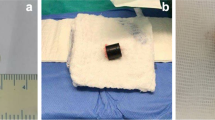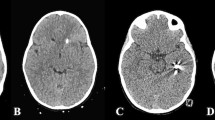Summary
This case report illustrates the unusual path of a bullet in the brain during a period of three years and its final successful removal from the floor of the fourth ventricle. — Since metallic foreign bodies may move within the brain, a surgically inaccessible fragment may later migrate and become accessible for surgical removal. Serial radiographs in varying projections and positions of the patient may thus provide valuable information.
Résumé
Cette observation illustre le trajet inhabituel d'une balle dans le cerveau pendant une période de 3 ans et enfin son extirpation avec succès du plancher du IVe ventricule. Puisque des corps étrangers métalliques peuvent se déplacer à l'intérieur du cerveau, un fragment initialement inaccessible chirurgicalement peu devenir extirpable ultérieurment, après migration.
Des sériographies en projection et position variables du crâne du patient peuvent done apporter de précieuse informations.
Zusammenfassung
Fallbeschreibung eines Patienten mit einem intracraniellen Geschoß, das im Gehirn wanderte und schließlich vom Boden des 4. Ventrikels operativ entfernt werden konnte.
Similar content being viewed by others
References
Adelala, A., Odeku, E.L.: Clinical Radiology 22, 312 (1971).
Campbell, E., Howard, W.D., Weary, W.B.: Arch. Surg. 44, 789 (1942).
Dandy, W.E.: The Brain. Chapter I [in] Lewis's Practice of Surgery, pp. 279–280. Hagerstown, Md.: W.F. Prior Co., Inc.
Furlow, L.T., Bender, M.B., Teuber, N.L.: J. Neurosurg. 4, 380 (1947).
Jefferson, G.: Brit. J. Surg. 5, 422 (1917).
Kelhammer, G.: Zbl. Chir. 66, 1773 (1939).
Long, E.K.: J. Louisiana med. Soc. 121, 167 (1969).
Maltby, G.I.: J. Neurosurg. 3, 239 (1946).
Markham, J.W., Stein, S., Pelligra, R., Lippe, P., Noyes, J.: J. Neurosurg. 34, 800 (1971).
Martin, J., Campbell, E.H.: J. Neurosurg. 3, 58 (1946).
Schnitker, M.T.: J. Neurosurg. 7, 173 (1950).
Sherman, J.J.: J. Neurosurg. 17, 483 (1960).
Small, J.M.: Brit. J. Surg. 32, 414 (1945).
Sternbergh, W.C.A., Jr., Watts, C., Clark, K.: J. Neurosurg. 34, 805 (1971).
Vilvandre, G., Morgan, J.D.: Arch. Radiol. Electrother. 21, 22 (1916).
Wood, E.H.: Amer. J. Radiol. 59, 1, 52 (1948).
Author information
Authors and Affiliations
Additional information
This work was supported in part by a Special Fellowship Award (2F 11 NS 2309-02 NSRB) and Special Fellowship Award (1 F11 NS 2325-02 NSRB).
Rights and permissions
About this article
Cite this article
Liebeskind, A.L., Anderson, R.D. & Schechter, M.M. Spontaneous movement of an intracranial missile. Neuroradiology 5, 129–132 (1973). https://doi.org/10.1007/BF00341526
Issue Date:
DOI: https://doi.org/10.1007/BF00341526




